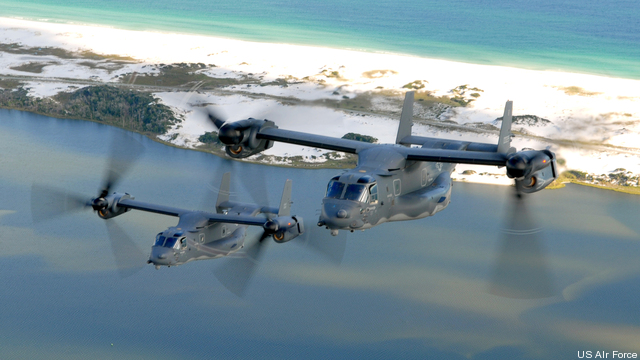AFSOC V-22 Crashes In Training; Five Injured
Posted on

WASHINGTON [Corrected at 6 pm Friday]: The latest crash of a V-22 tiltrotor may be a black mark on the aircraft’s safety record, but it won’t bring down the program. Despite literally decades of criticism — which is now certain to flare up again — there’s simply too much budgetary momentum, political support, and, yes, operational value to the V-22.
Yesterday evening, a CV-22 — the Air Force Special Operations version of the Osprey — crashed in Florida. (The 1st Special Operations Wing aircraft was based out of Hurlburt Field, part of Eglin Air Force Base in Florida). The five people aboard were injured and taken to local hospitals, but the Air Force announced this afternoon that none of their injuries was life-threatening; four crewmen were listed as stable and one in “guarded” condition. [Updated Friday 3:45 pm: Two of the crewmen were released from hospital Friday; three remain hospitalized]. The wing commander, Col. James Slife, said in a press conference there was no general safety issue apparent that would require grounding the CV-22 fleet.
Mercifully, no one was killed — this time. But yesterday’s accident comes on the heels of two deaths in April when a Marine Corps Osprey, formally called an MV-22, crashed in Morocco. The worst Osprey incident before that was in 2010, when another CV-22 crashed in Afghanistan, killing four and injuring 16, while until this year the Marine variant’s record had been clean since 2000, when a pair of crashes killed 23 Marines aboard. All told, according to the Project On Government Oversight, which has been relentlessly critical of the aircraft, 36 people have died in V-22s since the plane began flying.
That toll is tragic but it is not atypical for military aviation. For some grim perspective through May 7, when the military stopped publishing detailed causes of death, 384 military personnel had died in aircraft and helicopters crashes in Afghanistan, Iraq, the Philippines, and other operations associated with the “global war on terror,” 60 percent of them in accidents rather than in combat. While gunshots and roadside bomb attacks are far more frequent, a single transport aircraft can carry dozens of troops, which means that a mishap can be horrific.
Most inherently dangerous are helicopters, which by design routinely fly low over bad terrain and make hasty take-offs and landings in difficult places far from well-prepared airfields. Even training can be lethal. Counting accidents in the US and worldwide as well as the war zones, the US military has lost a staggering 468 414 helicopters since 9/11, killing 606 people. Four Army soldiers have died in two helicopter crashes in Afghanistan just since May 28th. V-22s fly like fixed-wing airplanes but take off and land like helicopters, exposing them to some similar risks, but to date only four have crashed since 9/11, killing just five Americans and one Afghan interpreter. Even allowing for the much smaller numbers of V-22s in service than conventional helicopters, that’s a respectable safety record in a dangerous business.
Even if the V-22 were substantially more dangerous than conventional helicopters, however, the military would still want it, because it can do things that helicopters can’t — just as helicopters can do things that safer fixed-wing planes cannot. The great advantage of helicopters, obviously, is that they can take off and land without a runway, but they’re aerodynamically less efficient than fixed-wing planes, which limits their speed, fuel efficiency, and range: Pilots say, only half jokingly, that a helicopter doesn’t really fly, it just beats the air into submission. Because the V-22 can change the angle at which its massive rotors spin from horizontal to vertical and back — hence the name “tilt-rotor” — it can take off and land like a helicopter but fly long-distance like a propeller plane, giving it much more speed and range.
The V-22’s edge in range and speed is helpful in Afghanistan, but it’s potentially invaluable in operations from the sea. Using tilt-rotors instead of helicopters allows Marines and special operators to hit targets well inland while the ships they launch from stay far offshore, outside the range of shore-based defenses like anti-ship cruise missiles. As the military increasingly emphasizes “AirSea Battle” and expeditionary operations in the face of “anti-access/area denial” strategies like those of China and Iran, the speed and range of the V-22 will only become more important — and more likely to save lives.
CORRECTION EXPLANATION: Co-author Rick Whittle explains why we corrected the story: “I keep a tally of rotorcraft crashes and transposed what should have been 417 into 471 when I added the CV-22 crash. Then, subtracting the three V-22s lost since 2001, I got 468 as the number of helicopters lost, when it should have been 414.” We regret the error and thank Rick for his diligence.
Subscribe to our newsletter
Promotions, new products and sales. Directly to your inbox.
